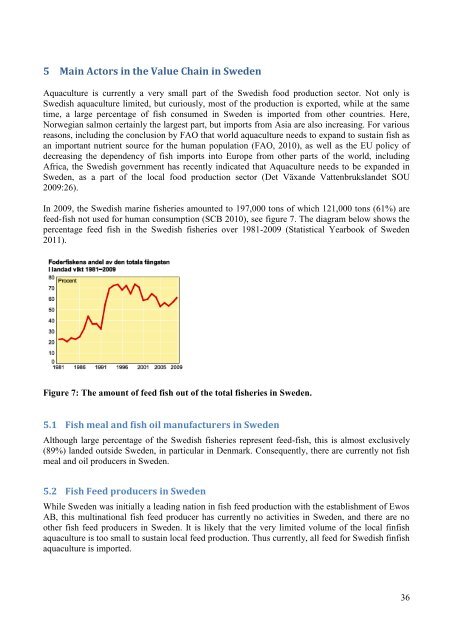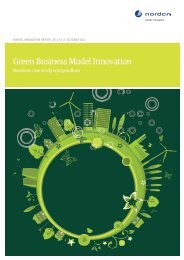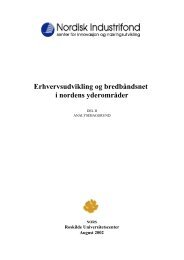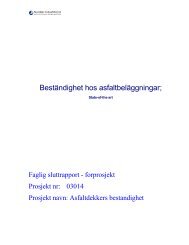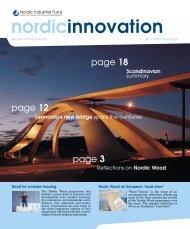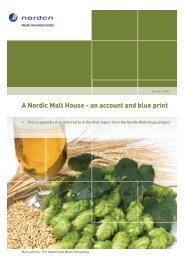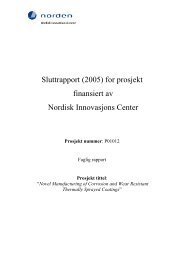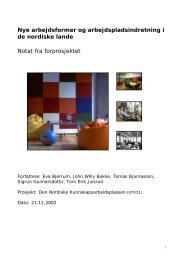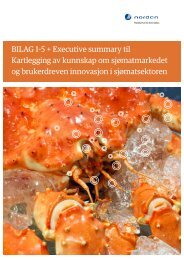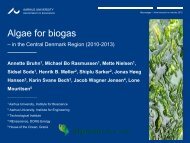Local raw materials for production of fish feed for ... - Nordic Innovation
Local raw materials for production of fish feed for ... - Nordic Innovation
Local raw materials for production of fish feed for ... - Nordic Innovation
You also want an ePaper? Increase the reach of your titles
YUMPU automatically turns print PDFs into web optimized ePapers that Google loves.
5 Main Actors in the Value Chain in Sweden<br />
Aquaculture is currently a very small part <strong>of</strong> the Swedish food <strong>production</strong> sector. Not only is<br />
Swedish aquaculture limited, but curiously, most <strong>of</strong> the <strong>production</strong> is exported, while at the same<br />
time, a large percentage <strong>of</strong> <strong>fish</strong> consumed in Sweden is imported from other countries. Here,<br />
Norwegian salmon certainly the largest part, but imports from Asia are also increasing. For various<br />
reasons, including the conclusion by FAO that world aquaculture needs to expand to sustain <strong>fish</strong> as<br />
an important nutrient source <strong>for</strong> the human population (FAO, 2010), as well as the EU policy <strong>of</strong><br />
decreasing the dependency <strong>of</strong> <strong>fish</strong> imports into Europe from other parts <strong>of</strong> the world, including<br />
Africa, the Swedish government has recently indicated that Aquaculture needs to be expanded in<br />
Sweden, as a part <strong>of</strong> the local food <strong>production</strong> sector (Det Växande Vattenbrukslandet SOU<br />
2009:26).<br />
In 2009, the Swedish marine <strong>fish</strong>eries amounted to 197,000 tons <strong>of</strong> which 121,000 tons (61%) are<br />
<strong>feed</strong>-<strong>fish</strong> not used <strong>for</strong> human consumption (SCB 2010), see figure 7. The diagram below shows the<br />
percentage <strong>feed</strong> <strong>fish</strong> in the Swedish <strong>fish</strong>eries over 1981-2009 (Statistical Yearbook <strong>of</strong> Sweden<br />
2011).<br />
Figure 7: The amount <strong>of</strong> <strong>feed</strong> <strong>fish</strong> out <strong>of</strong> the total <strong>fish</strong>eries in Sweden.<br />
5.1 Fish meal and <strong>fish</strong> oil manufacturers in Sweden<br />
Although large percentage <strong>of</strong> the Swedish <strong>fish</strong>eries represent <strong>feed</strong>-<strong>fish</strong>, this is almost exclusively<br />
(89%) landed outside Sweden, in particular in Denmark. Consequently, there are currently not <strong>fish</strong><br />
meal and oil producers in Sweden.<br />
5.2 Fish Feed producers in Sweden<br />
While Sweden was initially a leading nation in <strong>fish</strong> <strong>feed</strong> <strong>production</strong> with the establishment <strong>of</strong> Ewos<br />
AB, this multinational <strong>fish</strong> <strong>feed</strong> producer has currently no activities in Sweden, and there are no<br />
other <strong>fish</strong> <strong>feed</strong> producers in Sweden. It is likely that the very limited volume <strong>of</strong> the local fin<strong>fish</strong><br />
aquaculture is too small to sustain local <strong>feed</strong> <strong>production</strong>. Thus currently, all <strong>feed</strong> <strong>for</strong> Swedish fin<strong>fish</strong><br />
aquaculture is imported.<br />
36


